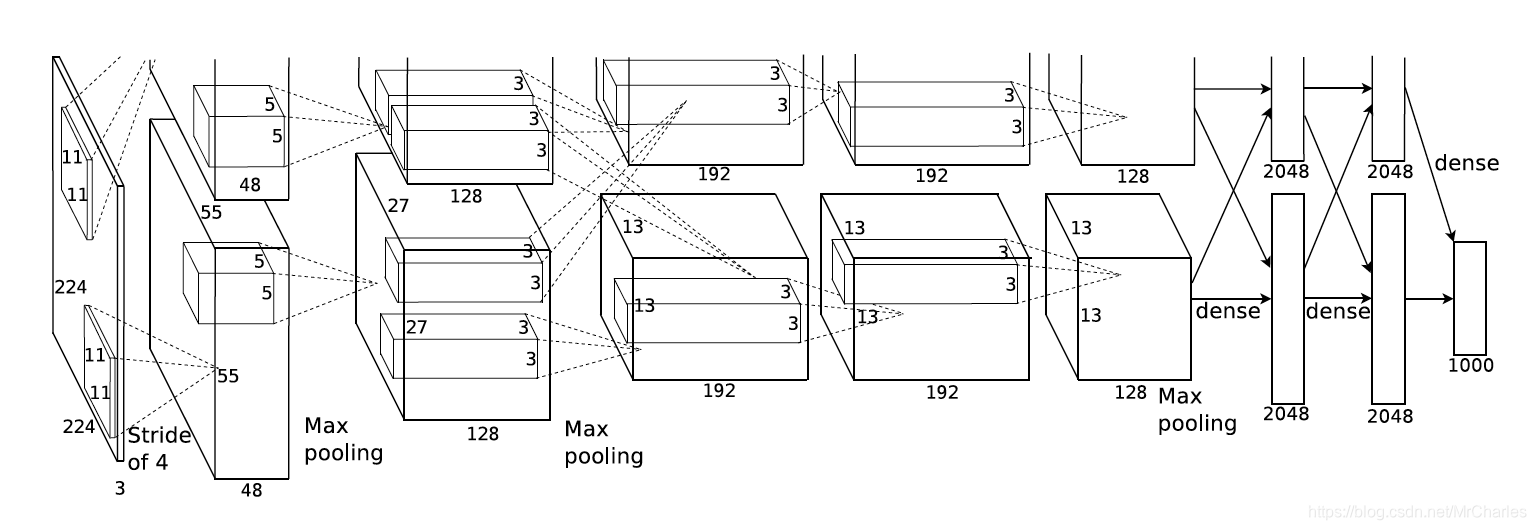神经网络 (2)- Alexnet Training on MNIST
Win10 Anaconda下配置tensorflow+jupyter notebook环境
1.安装anaconda
到Anaconda官网下载,我是用的是Anaconda3-4.8.0版本(Python3对应的是Anaconda3,Python2对应的是Anaconda2),根据需要下载即可。下载好之后点击exe文件安装没什么好讲的。
唯一需要特别说明的是,安装的过程中要把添加路径到环境中选项选中!安装完成之后到命令行输入命令验证是否成功安装:
conda --version
- 安装tensorflow 官方步骤创建环境,
If you installed a TensorFlow as it said in official documentation: https://www.tensorflow.org/versions/r0.10/get_started/os_setup.html#overview
I mean creating an environment called tensorflow and tested your installation in python, but TensorFlow can not be imported in jupyter, you have to install jupyter in your tensorflow environment too:
conda install jupyter notebook
After that I run a jupyter and it can import TensorFlow too:
jupyter notebook
AlexNet 识别MNIST

以上是AlexNet的结构,上下其实是一样的,共同用一套参数。 Similar structure to LeNet, AlexNet has more filters per layer, deeper and stacked. There are 5 convolutional layers, 3 fully connected layers and with Relu applied after each of them, and dropout applied before the first and second fully connected layer.AlexNet是2012年ImageNet比赛的冠军,虽然过去了很长时间,但是作为深度学习中的经典模型,AlexNet不但有助于我们理解其中所使用的很多技巧,而且非常有助于提升我们使用深度学习工具箱的熟练度。
from tensorflow.examples.tutorials.mnist import input_data
mnist = input_data.read_data_sets("/tmp/data/", one_hot=True)
import tensorflow as tf
#
learning_rate = 0.001
training_iters = 200000
batch_size = 64
display_step = 20
#
n_input = 784 #
n_classes = 10 #
dropout = 0.8 # Dropout
#
x = tf.placeholder(tf.float32, [None, n_input])
y = tf.placeholder(tf.float32, [None, n_classes])
keep_prob = tf.placeholder(tf.float32)
#
def conv2d(name, l_input, w, b):
return tf.nn.relu(tf.nn.bias_add(tf.nn.conv2d(l_input, w, strides=[1, 1, 1, 1], padding='SAME'),b), name=name)
#
def max_pool(name, l_input, k):
return tf.nn.max_pool(l_input, ksize=[1, k, k, 1], strides=[1, k, k, 1], padding='SAME', name=name)
#
def norm(name, l_input, lsize=4):
return tf.nn.lrn(l_input, lsize, bias=1.0, alpha=0.001 / 9.0, beta=0.75, name=name)
#
def alex_net(_X, _weights, _biases, _dropout):
#
_X = tf.reshape(_X, shape=[-1, 28, 28, 1])
#
conv1 = conv2d('conv1', _X, _weights['wc1'], _biases['bc1'])
#
pool1 = max_pool('pool1', conv1, k=2)
#
norm1 = norm('norm1', pool1, lsize=4)
# Dropout
norm1 = tf.nn.dropout(norm1, _dropout)
#
conv2 = conv2d('conv2', norm1, _weights['wc2'], _biases['bc2'])
#
pool2 = max_pool('pool2', conv2, k=2)
#
norm2 = norm('norm2', pool2, lsize=4)
# Dropout
norm2 = tf.nn.dropout(norm2, _dropout)
#
conv3 = conv2d('conv3', norm2, _weights['wc3'], _biases['bc3'])
conv4 = conv2d('conv4', conv3, _weights['wc4'], _biases['bc4'])
conv5 = conv2d('conv5', conv4, _weights['wc5'], _biases['bc5'])
pool5 = max_pool('pool5', conv5, k=2)
#
norm5 = norm('norm5', pool5, lsize=4)
# Dropout
norm5 = tf.nn.dropout(norm5, _dropout)
#
dense1 = tf.reshape(norm5, [-1, _weights['wd1'].get_shape().as_list()[0]])
dense1 = tf.nn.relu(tf.matmul(dense1, _weights['wd1']) + _biases['bd1'], name='fc1')
#
dense2 = tf.nn.relu(tf.matmul(dense1, _weights['wd2']) + _biases['bd2'], name='fc2') # Relu activation
#
out = tf.matmul(dense2, _weights['out']) + _biases['out']
return out
#
weights = {
'wc1': tf.Variable(tf.random_normal([11, 11, 1, 64])),
'wc2': tf.Variable(tf.random_normal([5, 5, 64, 192])),
'wc3': tf.Variable(tf.random_normal([3, 3, 192, 384])),
'wc4': tf.Variable(tf.random_normal([3, 3, 384, 256])),
'wc5': tf.Variable(tf.random_normal([3, 3, 256, 256])),
'wd1': tf.Variable(tf.random_normal([4*4*256, 1024])),
'wd2': tf.Variable(tf.random_normal([1024, 1024])),
'out': tf.Variable(tf.random_normal([1024, 10]))
}
biases = {
'bc1': tf.Variable(tf.random_normal([64])),
'bc2': tf.Variable(tf.random_normal([192])),
'bc3': tf.Variable(tf.random_normal([384])),
'bc4': tf.Variable(tf.random_normal([256])),
'bc5': tf.Variable(tf.random_normal([256])),
'bd1': tf.Variable(tf.random_normal([1024])),
'bd2': tf.Variable(tf.random_normal([1024])),
'out': tf.Variable(tf.random_normal([n_classes]))
}
#
pred = alex_net(x, weights, biases, keep_prob)
#
cost = tf.reduce_mean(tf.nn.softmax_cross_entropy_with_logits(logits=pred, labels=y))
optimizer = tf.train.AdamOptimizer(learning_rate=learning_rate).minimize(cost)
#
correct_pred = tf.equal(tf.argmax(pred,1), tf.argmax(y,1))
accuracy = tf.reduce_mean(tf.cast(correct_pred, tf.float32))
#
init = tf.initialize_all_variables()
#
with tf.Session() as sess:
sess.run(init)
step = 1
# Keep training until reach max iterations
while step * batch_size < training_iters:
batch_xs, batch_ys = mnist.train.next_batch(batch_size)
#
sess.run(optimizer, feed_dict={x: batch_xs, y: batch_ys, keep_prob: dropout})
if step % display_step == 0:
#
acc = sess.run(accuracy, feed_dict={x: batch_xs, y: batch_ys, keep_prob: 1.})
#
loss = sess.run(cost, feed_dict={x: batch_xs, y: batch_ys, keep_prob: 1.})
print ("Iter " + str(step*batch_size) + ", Minibatch Loss= " + "{:.6f}".format(loss) + ", Training Accuracy= " + "{:.5f}".format(acc))
step += 1
print ("Optimization Finished!")
#
print ("Testing Accuracy:", sess.run(accuracy, feed_dict={x: mnist.test.images[:256], y: mnist.test.labels[:256], keep_prob: 1.}))
神经网络 (2)- Alexnet Training on MNIST的更多相关文章
- 利用CNN神经网络实现手写数字mnist分类
题目: 1)In the first step, apply the Convolution Neural Network method to perform the training on one ...
- 第十六节,卷积神经网络之AlexNet网络实现(六)
上一节内容已经详细介绍了AlexNet的网络结构.这节主要通过Tensorflow来实现AlexNet. 这里做测试我们使用的是CIFAR-10数据集介绍数据集,关于该数据集的具体信息可以通过以下链接 ...
- 卷积神经网络之AlexNet
由于受到计算机性能的影响,虽然LeNet在图像分类中取得了较好的成绩,但是并没有引起很多的关注. 知道2012年,Alex等人提出的AlexNet网络在ImageNet大赛上以远超第二名的成绩夺冠,卷 ...
- 第十五节,卷积神经网络之AlexNet网络详解(五)
原文 ImageNet Classification with Deep ConvolutionalNeural Networks 下载地址:http://papers.nips.cc/paper/4 ...
- 卷积神经网络之AlexNet网络模型学习
ImageNet Classification with Deep Convolutional Neural Networks 论文理解 在ImageNet LSVRC-2010上首次使用大型深度卷 ...
- 吴裕雄 PYTHON 神经网络——TENSORFLOW 无监督学习处理MNIST手写数字数据集
# 导入模块 import numpy as np import tensorflow as tf import matplotlib.pyplot as plt # 加载数据 from tensor ...
- TensorFlow实战:Chapter-4(CNN-2-经典卷积神经网络(AlexNet、VGGNet))
转载自:http://blog.csdn.net/u011974639/article/details/76146822 项目:https://www.cs.toronto.edu/~frossard ...
- 学习笔记TF057:TensorFlow MNIST,卷积神经网络、循环神经网络、无监督学习
MNIST 卷积神经网络.https://github.com/nlintz/TensorFlow-Tutorials/blob/master/05_convolutional_net.py .Ten ...
- 卷积神经网络CNN识别MNIST数据集
这次我们将建立一个卷积神经网络,它可以把MNIST手写字符的识别准确率提升到99%,读者可能需要一些卷积神经网络的基础知识才能更好的理解本节的内容. 程序的开头是导入TensorFlow: impor ...
随机推荐
- 数据挖掘 FP-tree算法C++实现及源码
FP-growth挖掘算法 步骤一 扫描数据库,扫描数据库一次,得到频繁1-项集,把项按支持度递减排序,再一次扫描数据库,建立FP-tree 步骤二 对每个项,生成它的 条件模式库 步骤三 用条件模式 ...
- 前端(十九)—— Bootstrap框架
Bootstrap Bootstrap中文文档 一.简介 Bootstrap是美国Twitter公司的设计师Mark Otto和Jacob Thornton合作基于HTML.CSS.JavaScrip ...
- C# WinfForm 控件之dev图表 ChartControl
dev 图表控件 学习连接 新建一个winformApp form1上放一个button 再放一个chartControl Name 为cct 直接上代码 private void button1_C ...
- 【转】elasticsearch中字段类型默认显示{ "foo": { "type": "text", "fields": { "keyword": {"type": "keyword", "ignore_above": 256} }
官方原文链接:https://www.elastic.co/cn/blog/strings-are-dead-long-live-strings 转载原文连接:https://segmentfault ...
- dnslog小技巧
一.dnslog利用场景 主要针对无回显的情况. Sql-Blind RCE SSRF RFI(Remote File Inclusion) 二.原理 将dnslog平台中的特有字段payload带入 ...
- linux 下格式化命令小记
mkfs.ext4 /dev/sda1 # 格式化为ext4分区mkfs.ext3 /dev/sda1 # 格式化为ext3分区mkfs.ext2 /dev/sda1 # 格式化为e ...
- Spring boot热部署实战
1.介绍 在开发工程中,修改一点儿代码,想看效果就需要重新启动服务,这样会花费大量时间在重启服务上,通过devtools热部署可以大大减少重启服务的时间. 之所以能减少时间,是因为Spring Boo ...
- mui框架页面每次加载操作
最近在优化自己用mui开发的app,主要还是针对交互这块儿,这里简单给大家说一下问题点场景,就是我是通过动态添加底部tabBar的方法创建了一个底部可以切换的操作区域,代码如下: mui.init() ...
- join加入线程
join线程会抢先拿到cup来执行线程,然后其他的线程再来执行. 案例: public static void main(String args[]){ //创建线程对象 Thread myThrea ...
- 过滤器 一 Filter
import javax.servlet.Filter; 前言 过滤器是一个程序,依赖与servlet容器,它先于与之相关的servlet或JSP页面运行在服务器上.过滤器可附加到一个或多个servl ...
